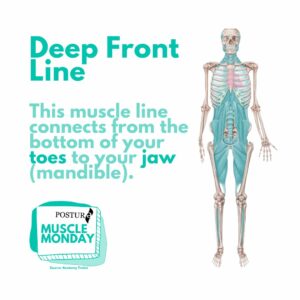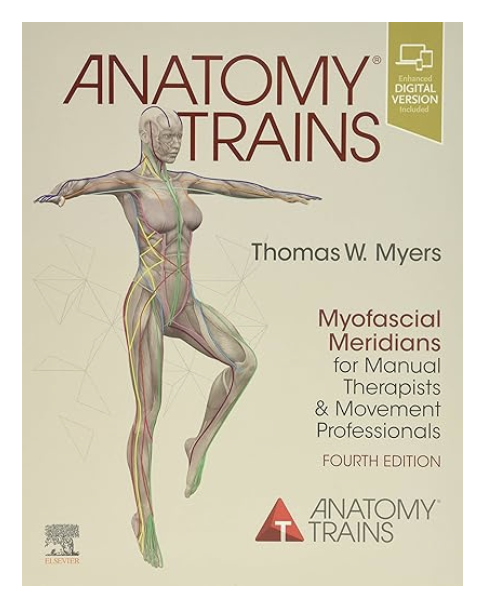The Ribbons that Run Through Our Body
Here at Posture Restorations, we manipulate muscles through Muscle Meridians from our posture assessments including ZYTO scan (Biofeedback).
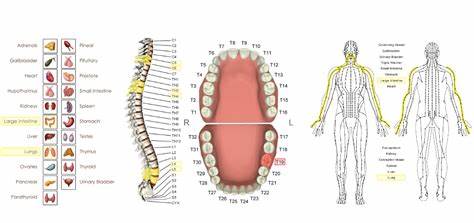
Superficial Back Line (Bladder Meridian)
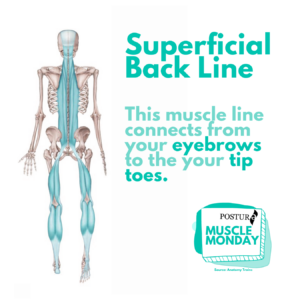
The overall postural function of the SBL is to support the body in full upright extension, to prevent the tendency to curl over into flexion exemplified by the fetal position. This all-day postural function requires a higher proportion of slow-twitch, endurance muscle fibers in the muscular portions of this myofascial band. The constant postural demand also requires extra-heavy sheets and bands in the fascial portion, as in the Achilles tendon, hamstrings, the ‘cables’ of the erector spinae, and the occipital ridge.
The exception to the extension function comes at the knees, which, unlike other joints, are flexed to the rear by the muscles of the SBL. In standing, the interlocked tendons of the SBL assist the cruciate ligaments in the maintaining the postural alignment between the tibia and the femur. Source & Buy Book: Anatomy Trains by Thomas W. Meyers
Superficial Front Line (Stomach Meridian)
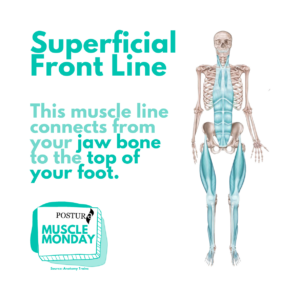
The function of the SFL is to balance the Superficial back line (SBL), and to provide tensile support from the top to lift those parts of the skeleton which extend forward of the gravity line – the pubis, rib cage, and face. Myofascia of the SFL also maintain the postural extension of the knee. The muscles of the SFL stand ready to defend the soft and sensitive parts that adorn the front surface of the human body, and protect the viscera of the ventral cavity. Such as the throat, breast, belly, Groin, and Genitals.
Lateral Line (Gallbladder Meridian)
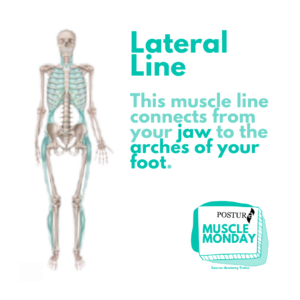 The LL functions posturally to balance front and back, and bilaterally to balance left and right. The LL also mediates forces among the other superficial lines – the Superficial Front Line, the Superficial Back Line, all the Arm Lines, and the Spiral Line. The LL often acts to stabilize the trunk and legs in a coordinated manner to prevent buckling of the structure during activity.
The LL functions posturally to balance front and back, and bilaterally to balance left and right. The LL also mediates forces among the other superficial lines – the Superficial Front Line, the Superficial Back Line, all the Arm Lines, and the Spiral Line. The LL often acts to stabilize the trunk and legs in a coordinated manner to prevent buckling of the structure during activity.
Superficial Front Arm Lines (Pericardium Meridian)
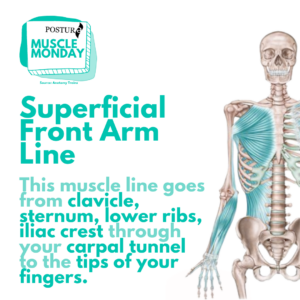
The Superficial Front Arm Line (SFAL) ooverlies the DFAL (Deep Front Arm Line) in the shoulder, beginning with a broad sweep of attachments, which in this line includes several muscles.
The pectoralis major, which was broad set of attachments from the clavicle down onto the middle ribs, egins this line in the front.
The Latissiumus dorsi (which egins its emryological life as ‘latissiums ventri’, a muscle on the front with the a firm attachment to the anterior surface of the humerous, next to pectoralis, this staking its tenuous claim to being part of the SFAL) sweeps up the from the spinous processes of the lower thooracics, the lumbosacral fascia, the iliac crest, and lower lateral ribs.
Deep Front Arm Lines (Lung Meridian)
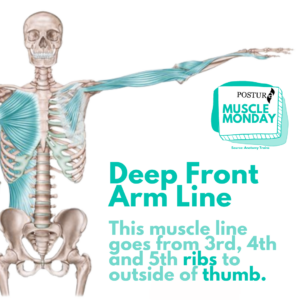 Since the arms hang from the upper skeleton in our upright posture, they are not part of the structural ‘column’ as such. Thus we have included the appendicular legs in our discussion of the cardinal and spiral lines, but left the arms for seperate consideration. Given their lines, but left the arms for separate consideration. Given their weight, however, and their multiple links to our activities of daily driving and computer life, the Arm Lines do have a postural function: strain from the elos affects the mid-ack, and shoulder malposition can create create significant drag on the ris, neck, breathing function, and beyond.
Since the arms hang from the upper skeleton in our upright posture, they are not part of the structural ‘column’ as such. Thus we have included the appendicular legs in our discussion of the cardinal and spiral lines, but left the arms for seperate consideration. Given their lines, but left the arms for separate consideration. Given their weight, however, and their multiple links to our activities of daily driving and computer life, the Arm Lines do have a postural function: strain from the elos affects the mid-ack, and shoulder malposition can create create significant drag on the ris, neck, breathing function, and beyond.
Superficial Back Arm Lines (Triple Energizer Meridian)
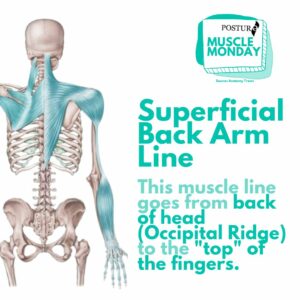
Since the arms hang from the upper skeleton in our upright posture, they are not part of the structural ‘column’ as such. Thus we have included the appendicular legs in our discussion of the cardinal and spiral lines, but left the arms for seperate consideration. Given their lines, but left the arms for separate consideration. Given their weight, however, and their multiple links to our activities of daily driving and computer life, the Arm Lines do have a postural function: strain from the elos affects the mid-ack, and shoulder malposition can create create significant drag on the ris, neck, breathing function, and beyond.
Deep Back Arm Lines (Small Intestines Meridian)
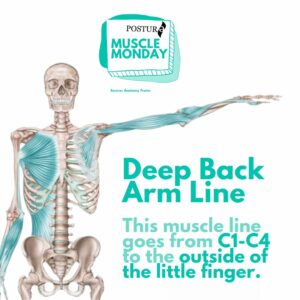
The DBALopens with the rhomboids, whose superficial layers of fascia pass across to the infraspinatus. The DBAL is the entire rotator cuff complex that sanwhiches the scapula, including the subscapularis.
Deep Front (Liver Meridian)
The DFL plays a major role in the body’s support:
- Lifting in the inner arch;
Stabalizing each segment of the legs, including the hip; - Supporting the lumbbar spine from the front;
- Surrounding and shaping the abdominopelvic balloon;
- Stabalizing the chest while allowing the expansion and relaxation of breathing
- Balancing the fragile neck and heavy head atop it all.
Lack of support, balance, and proper tonus in the DFL (as in the common pattern where short DFL myofascia does not allow the hip joint to open fully into extension) will produce overall shortening in the body, encourage collapse in the pelvic and spinal core, and lay the groundwork for negative compensatory adjustments in all the other lines we have decribed.
Spiral Line (Stomach & Bladder Meridian)
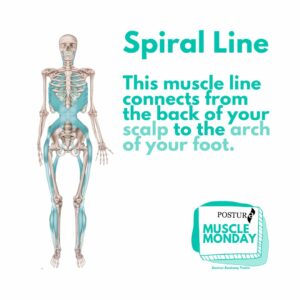
The overall movement function of the SPL is to create and mediate oblique spirals and rotations in the body, and, in eccentric and isometric contraction, to steady th etrunk and leg to keep it from folding into rotational collapse.
